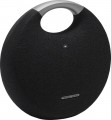The total sound power provided by the audio system at maximum volume, in other words, the total power of all the speakers provided by the device (including the subwoofer).
The higher the power, the louder the system will sound and the larger the area it can cover. On the other hand,
high power significantly affects the price, dimensions, weight and power consumption of the device. In addition, when evaluating and comparing according to this indicator, it is worth considering some nuances. Firstly, some manufacturers go to the trick and give in the characteristics not the average, but the peak sound power; such numbers can be quite impressive, but they have very little to do with real loudness. So if it seems to you that the claimed power is too high, it's ok to clarify what exactly is meant in this case. Secondly, when comparing, it is worth considering the presence of a subwoofer — it plays an auxiliary role, but it can account for more than half of the total system power. Because of this, for equal total power, a device with a subwoofer may be quieter than a model without a subwoofer: for example, a 2.0 40W system will have 20W per main channel, while a 2.1 40W model may have 20W per subwoofer, and only 10 watts for the main speakers.
Sensitivity determines the intensity of the acoustics response to a signal of a certain level; Simply put, the higher this figure, the higher the volume of the speaker system will be at the same signal level. Note that in the case of audio systems, this parameter plays a secondary role: it is important for selecting acoustics for an amplifier, and here both of these components are in most cases optimally matched by the manufacturer to each other.
A passive radiator can be simply described as a low-frequency speaker that does not have its own reproducing system (coil with magnet). It is driven by pressure fluctuations created by active drivers and acts as a resonator to deliver deep, rich bass—especially useful for systems that do not include a subwoofer. At the same time, unlike phase inverters, passive radiators do not generate additional noise.

